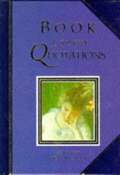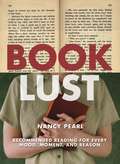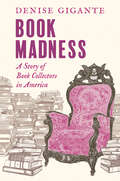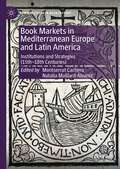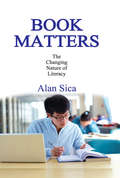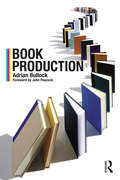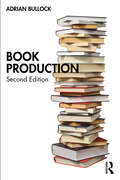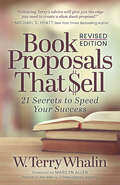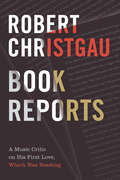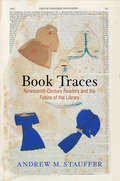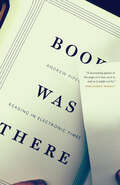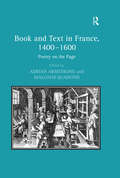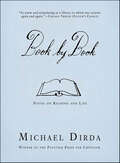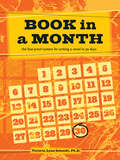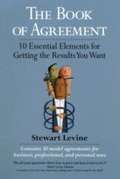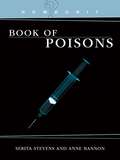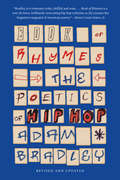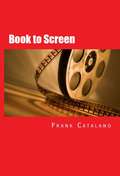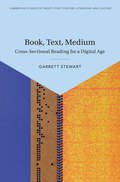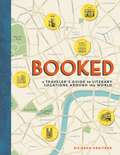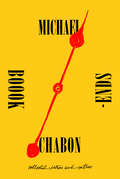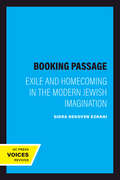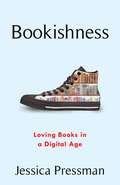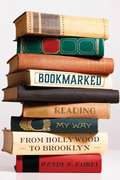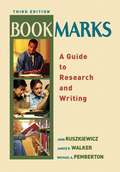- Table View
- List View
Book Lovers Quotations (Quotation Giftbooks)
by Helen ExleyThis little collection of quotations will bring joy to those who love books. Here, in one small volume, is the quintessential wit of Groucho Marx, the hardhitting bluntness of Hemingway, the sarcasm of Bertrand Russell. Here are what the authors themselves feel about books: from Oscar Wilde and Mao Tse Tung, Solzhenitsyn and Dylan Thomas, to Thomas a Kempis and Anne Frank. Plus the thoughts of ordinary people about the role of books in their lives: 'Any new book read to fill an idle hour could send you to the ends of the earth, change your career, affirm or obliterate your faith. Be warned.' In Lavish art reproductions Readers and reading are shown as perceived by several artists. Works complement the meaning of the quotes. Image descriptions convey the people, objects and places depicted, the mood conveyed and the possible intent of the artists.
Book Lust: A Sourcebook for Understanding the Cuisines of the World
by Nancy PearlWhat to read next is every book lover's greatest dilemma. Nancy Pearl comes to the rescue with this wide-ranging and fun guide to the best reading new and old. Pearl, who inspired legions of litterateurs with "What If All (name the city) Read the Same Book," has devised reading lists that cater to every mood, occasion, and personality. These annotated lists cover such topics as mother-daughter relationships, science for nonscientists, mysteries of all stripes, African-American fiction from a female point of view, must-reads for kids, books on bicycling, "chick-lit," and many more. Pearl's enthusiasm and taste shine throughout.
Book Madness: A Story of Book Collectors in America
by Denise GiganteThe fascinating history of American bookishness as told through the sale of Charles Lamb&’s library in 1848 Charles Lamb&’s library—a heap of sixty scruffy old books singed with smoke, soaked with gin, sprinkled with crumbs, stripped of illustrations, and bescribbled by the essayist and his literary friends—caused a sensation when it was sold in New York in 1848. The transatlantic book world watched as the relics of a man revered as the patron saint of book collectors were dispersed. Following those books through the stories of the bibliophiles who shaped intellectual life in America—booksellers, publishers, journalists, editors, bibliographers, librarians, actors, antiquarians, philanthropists, politicians, poets, clergymen—Denise Gigante brings to life a lost world of letters at a time when Americans were busy assembling the country&’s major public, university, and society libraries. A human tale of loss, obsession, and spiritual survival, this book reveals the magical power books can have to bring people together and will be an absorbing read for anyone interested in what makes a book special.
Book Markets in Mediterranean Europe and Latin America: Institutions and Strategies (15th-18th Centuries) (New Directions in Book History)
by Montserrat Cachero Natalia Maillard-ÁlvarezThis book depicts the Early Modern book markets in Europe and colonial Latin America. The nature of book production and distribution in this period resulted in the development of a truly international market. The integration of the book market was facilitated by networks of printers and booksellers, who were responsible for the connection of distant places, as well as local producers and merchants. At the same time, due to the particular nature of books, political and religious institutions intervened in book markets. Printers and booksellers lived in a politically fragmented world where religious boundaries often shifted. This book explores both the development of commercial networks as well as how the changing institutional settings shaped relationships in the book market.
Book Matters: The Changing Nature of Literacy
by Alan SicaScholars have been puzzling over the "future of the book" since Marshall McLuhan's famous maxim "the medium is the message" in the early 1950s. McLuhan famously argued that electronic media was creating a global village in which books would become obsolete. Such views were ahead of their time, but today they are all too relevant as declining sales, even among classic texts, have become a serious matter in academic publishing.Does anyone still read long and complex works, either from the past or the present? Is the role of a professional reader and reviewer of manuscripts still relevant? Book Matters closely analyses these questions and others. Alan Sica surmises that the concentration span required for studying and discussing complex texts has slipped away, as undergraduate classes are becoming inundated by shorter, easier-to-teach scholarly and literary works. He considers such matters in part from the point of view of a former editor of scholarly journals. In an engaging style, he gives readers succinct analyses of books and ideas that once held the interest of millions of discerning readers, such as Simone de Beavoir's Second Sex and the works of David Graham Phillips and C. Wright Mills, among others.Book Matters is not a nostalgic cry for lost ideas, but instead a stark reminder of just how aware and analytically illuminating certain scholars were prior to the Internet, and how endangered the book is in this era of pixelated communication.
Book Production
by Adrian BullockThe digital revolution has brought with it a wider range of options for creating and producing print on paper products than ever seen before. With the growing demand for skills and knowledge with which to exploit the potential of digital technology, comes the need for a comprehensive book that not only makes it possible for production staff, editors, and designers to understand how the technology affects the industry they work in, but also provides them with the skills and competencies they need to work in it smartly and effectively. This book is designed to satisfy this need. Book Production falls into two parts: The first part deals with the increasingly important role of production as project managers, a role which has not been adequately written about in any of the recent literature on publishing. The second part deals with the processes and raw materials used in developing and manufacturing print on paper products. Case studies are used to illustrate why and how some processes or raw materials may or may not be appropriate for a particular job. With expert opinions and case studies, and a consideration of the practices and issues involved, this offers a comprehensive overview of book production for anyone working, or training to work in or in conjunction with the books industry.
Book Production
by Adrian BullockNow in its second edition, this book offers a comprehensive introduction to book project management and production, including the creation and development of digital products.Book Production explains how books and digital products are planned for and managed, and why certain processes and raw materials are chosen. Addressing the growing demand for skills and knowledge with which to exploit digital and traditional technology, while ensuring ethical, environmentally and sustainably conscious decision-making across the publishing industry, this second edition pays special attention to green production practices and considers questions such as what makes a green supplier green; what impact different raw material choices have on the environment; and how to deal with waste management. Legal matters, including contracts and risk assessment and mitigation, are also discussed. Throughout the book, case studies are used to aid comprehension and engagement.Ideally suited to advanced students of publishing and book studies, Book Production will be of value to anyone working or training to work in or in conjunction with the book industry
Book Proposals That Sell: 21 Secrets to Speed Your Success
by W. Terry WhalinDiscover the Secrets to Getting Published. Writing a book? In the beginning stages of writing a book, most people start with a blank page and write their entire manuscript. According to author and acquisitions editor W. Terry Whalin, this approach is backwards. About 80% to 90% of nonfiction books are sold from a book proposal. This mysterious document called a proposal contains many elements that will never appear in a manuscript—yet these details are critical to publishing executives who make the decision about publishing or rejecting an author’s project. In Book Proposals That Sell, Terry reveals 21 secrets to creating a book proposal that every author needs in order to create one that sells.
Book Reports: A Music Critic on His First Love, Which Was Reading
by Robert ChristgauIn this generous collection of book reviews and literary essays, legendary Village Voice rock critic Robert Christgau showcases the passion that made him a critic—his love for the written word. Many selections address music, from blackface minstrelsy to punk and hip-hop, artists from Lead Belly to Patti Smith, and fellow critics from Ellen Willis and Lester Bangs to Nelson George and Jessica Hopper. But Book Reports also teases out the popular in the Bible and 1984 as well as pornography and science fiction, and analyzes at length the cultural theory of Raymond Williams, the detective novels of Walter Mosley, the history of bohemia, and the 2008 financial crisis. It establishes Christgau as not just the Dean of American Rock Critics, but one of America's most insightful cultural critics as well.
Book Traces: Nineteenth-Century Readers and the Future of the Library (Material Texts)
by Andrew M. StaufferIn most college and university libraries, materials published before 1800 have been moved into special collections, while the post-1923 books remain in general circulation. But books published between these dates are vulnerable to deaccessioning, as libraries increasingly reconfigure access to public-domain texts via digital repositories such as Google Books. Even libraries with strong commitments to their print collections are clearing out the duplicates, assuming that circulating copies of any given nineteenth-century edition are essentially identical to one another. When you look closely, however, you see that they are not.Many nineteenth-century books were donated by alumni or their families decades ago, and many of them bear traces left behind by the people who first owned and used them. In Book Traces, Andrew M. Stauffer adopts what he calls "guided serendipity" as a tactic in pursuit of two goals: first, to read nineteenth-century poetry through the clues and objects earlier readers left in their books and, second, to defend the value of keeping the physical volumes on the shelves. Finding in such books of poetry the inscriptions, annotations, and insertions made by their original owners, and using them as exemplary case studies, Stauffer shows how the physical, historical book enables a modern reader to encounter poetry through the eyes of someone for whom it was personal.
Book Was There: Reading in Electronic Times
by Andrew PiperAndrew Piper grew up liking books and loving computers. While occasionally burying his nose in books, he was going to computer camp, programming his Radio Shack TRS-80, and playing Pong. His eventual love of reading made him a historian of the book and a connoisseur of print, but as a card-carrying member of the first digital generation--and the father of two digital natives--he understands that we live in electronic times. Book Was There is Piper's surprising and always entertaining essay on reading in an e-reader world. Much ink has been spilled lamenting or championing the decline of printed books, but Piper shows that the rich history of reading itself offers unexpected clues to what lies in store for books, print or digital. From medieval manuscript books to today's playable media and interactive urban fictions, Piper explores the manifold ways that physical media have shaped how we read, while also observing his own children as they face the struggles and triumphs of learning to read. In doing so, he uncovers the intimate connections we develop with our reading materials--how we hold them, look at them, share them, play with them, and even where we read them--and shows how reading is interwoven with our experiences in life. Piper reveals that reading's many identities, past and present, on page and on screen, are the key to helping us understand the kind of reading we care about and how new technologies will--and will not--change old habits. Contending that our experience of reading belies naive generalizations about the future of books, Book Was There is an elegantly argued and thoroughly up-to-date tribute to the endurance of books in our ever-evolving digital world.
Book and Text in France, 1400–1600: Poetry on the Page
by Malcolm QuaintonIn recent years, literary scholars have come increasingly to acknowledge that an adequate understanding of texts requires the study of books, the material objects through which the meanings of texts are constructed. Focusing on French poetry in the period 1400-1600, contributors to this volume analyze layout, illustration, graphology, paratext, typography, anthologization, and other such elements in works by a variety of writers, among them Charles d'Orléans, Jean Bouchet, Pierre de Ronsard and Louise Labé. They demonstrate how those elements play a crucial role in shaping the relationships between authors, texts, contexts, and readers, and how these relationships change as the nature of the book evolves. An introduction to the volume outlines the methodological implications of studying the materiality of literature in this period; situates the various papers in relation to each other and to the field as a whole; and indicates possible future directions of research in the field. By engaging with issues of major current methodological concern, this volume appeals to all scholars interested in the materiality of the literary text, including the burgeoning field of text-image studies, not only in French but also in other national literatures. In addition, it enables fruitful connections to be made between late-medieval and Renaissance literature, areas still often studied in isolation from each other.
Book by Book: Notes on Reading and Life
by Michael Dirda“As warm and stimulating as a library to which one returns again and again,” the Pulitzer Prize–winning critic discusses the rewards of reading books (Chicago Tribune, Editor's Choice).Once out of school, most of us read for pleasure. Yet there is another equally important, though often overlooked, reason that we read: to learn how to live. Though books have always been understood as life-teachers, the exact way in which they instruct, cajole, and convince remains a subject of some mystery. Drawing on sources as diverse as Dr. Seuss and Simone Weil, P. G. Wodehouse and Isaiah Berlin, Pulitzer Prize–winning critic Michael Dirda shows how the wit, wisdom, and enchantment of the written word can inform and enrich nearly every aspect of life, from education and work to love and death.Organized by significant life events and abounding with quotations from great writers and thinkers, Book by Book showcases Dirda's considerable knowledge, which he wears lightly. Favoring showing rather than telling, Dirda draws the reader deeper into the classics, as well as lesser-known works of literature, history, and philosophy, always with an eye to what is relevant to how we might better understand our lives.“Highly cultured yet never pretentious, Dirda's survey convincingly demonstrates what a wealth of life lessons—moral, emotional and aesthetic—a good library can contain.” —Publishers Weekly
Book in a Month: The Fool-Proof System for Writing a Novel in 30 Days
by Victoria Lynn SchmidtWhat Can You Accomplish in 30 Days? If you make time to write and put away all of your excuses, could you stay on track and finish your novel in only a month? With a structured plan and a focused goal, yes, you can! Using a combination of flexible weekly schedules, focused instruction, and detailed worksheets, author Victoria Schmidt leads you through a proven 30-day novel-writing system without the intimidation factor. Book in a Month shows you how to: Set realistic goals and monitor your progress Manage your time so that your writing life has room to flourish Select a story topic that will continue to inspire you throughout the writing process Quickly outline your entire story so that you have a clear idea of how your plot and characters are going to develop before you start writing Draft each act of your story by focusing on specific turning points Keep track of the areas you want to revise without losing your momentum in the middle of your story Relax and have fun–you are, after all, doing something you love So what are you waiting for? If you've been putting off your book project, let Book in a Month be your guide and find out just how much you can accomplish.
Book of Agreement: 10 Essential Elements for Getting the Results You Want
by Stewart LevineThe Book of Agreement suggests that it is best to change the process of forming agreements from an adversarial, win/lose negotiation, to a joint visioning process.
Book of Poisons: A Guide for Writers
by Serita Stevens Anne BannonDiscover Deadly Doses to Kill Off Characters The readers of your crime and mystery stories should be trying to figure out "whodunit"#150;not wondering why your facts don't make sense. If you want to kill off characters with something poisonous, you need to know how a villain would gain access to such a poison, how it would be administered, and what the effects on the victim would be. Book of Poisonscan help you figure out all of the details of proper poisoning. This thorough guide catalogs the classic poisons, household poisons, poisonous animals and plants, poisons used in wars, and more. With information on toxicity, reaction time, effects and symptoms, and antidotes and treatments, you'll know exactly what your villain needs to succeed and exactly what could foil his plans. You'll also find: information about how real toxicologists uncover poisoning crimes a history of famous poisoners advice on how you can create your own fictional poison case histories that give examples of when the poisons listed were used in literature, movies, and real life With alphabetical organization and appendices that cross-reference by symptoms, form, administration, and other methods, you'll be able to find the perfect poisons to fit your plot. Plus, a glossary of medical terms makes decoding symptoms and treatments easy for the writer with no medical background. Book of Poisonsis the comprehensive reference you need to create deaths by poison without stopping readers dead in their tracks over misguided facts.
Book of Rhymes: The Poetics of Hip Hop
by Adam BradleyIf asked to list the greatest innovators of modern American poetry, few of us would think to include Jay-Z or Eminem in their number. And yet hip hop is the source of some of the most exciting developments in verse today. The media uproar in response to its controversial lyrical content has obscured hip hop's revolution of poetic craft and experience: Only in rap music can the beat of a song render poetic meter audible, allowing an MC's wordplay to move a club-full of eager listeners.Examining rap history's most memorable lyricists and their inimitable techniques, literary scholar Adam Bradley argues that we must understand rap as poetry or miss the vanguard of poetry today. Book of Rhymes explores America's least understood poets, unpacking their surprisingly complex craft, and according rap poetry the respect it deserves.
Book to Screen (How to Adapt Your Novel to a Screenplay #5)
by Frank CatalanoADAPTING YOUR NOVEL INTO A SCREENPLAY BOOK TO SCREEN was first presented as part of the 25th Annual Writer's Conference sponsored by San Diego State University on February 6 through the 8th, 2009 at the Double Tree Hilton Hotel in Mission Hills, California. The following transcript was presented and recorded by Frank Catalano as part of the programs offered at the conference. The book is based partly upon that presentation, focuses on the adaptation of an existing novel into a screenplay for presentation as a motion picture, television program or Internet content. Writers of fiction and non-fiction and industry professionals from the publishing business primarily attended the 25th Annual Writer's Conference. Mr. Catalano's seminars focused upon those writers seeking to adapt their novels into screenplays. The complete list of seminar presentations by Frank Catalano for this conference is: BOOK 1: WRITE GREAT CHARACTERS IN THE FIRST TEN PAGES BOOK 2: WRITING ON YOUR FEET - IMPROVISATIONAL TECHNIQUES FOR WRITERS - Part 1 BOOK 3: START YOUR STORY AT THE END BOOK 4: THE FIRST TEN PAGES BOOK 5: BOOK TO SCREEN BOOK 6: ACTING IT OUT - IMPROVISATIONAL TECHNIQUES FOR WRITERS - Part 2 BOOK 7: WRITE GREAT DIALOGUE
Book, Text, Medium: Cross-Sectional Reading for a Digital Age (Cambridge Studies in Twenty-First-Century Literature and Culture)
by Garrett StewartBook, Text, Medium: Cross Sectional Reading for a Digital Age utilizes codex history, close reading, and language philosophy to assess the transformative arc between medieval books and today's e-books. It examines what happens to the reading experience in the twenty-first century when the original concept of a book is still held in the mind of a reader, if no longer in the reader's hand. Leading critic Garrett Stewart explores the play of mediation more generally, as the concept of book moves from a manufactured object to simply the language it puts into circulation. Framed by digital poetics, phonorobotics, and the rising popularity of audiobooks, this study sheds new light on both the history of reading and the negation of legible print in conceptual book art.
Booked: A Traveler's Guide to Literary Locations Around the World
by Richard KreitnerA practical, armchair travel guide that explores eighty of the most iconic literary locations from all over the globe that you can actually visit. A must-have for every fan of literature, Booked inspires readers to follow in their favorite characters footsteps by visiting the real-life locations portrayed in beloved novels including the Monroeville, Alabama courthouse in To Kill a Mockingbird, Chatsworth House, the inspiration for Pemberley in Pride and Prejudice, and the Kyoto Bridge from Memoirs of a Geisha. The full-color photographs throughout reveal the settings readers have imagined again and again in their favorite books. Organized by regions all around the world, author Richard Kreitner explains the importance of each literary landmark including the connection to the author and novel, cultural significance, historical information, and little-known facts about the location. He also includes travel advice like addresses and must-see spots. Booked features special sections on cities that inspired countless literary works like a round of locations in Brooklyn from Betty Smith's iconic A Tree Grows in Brooklyn to Jonathan Lethem's Motherless Brooklyn and a look at the New Orleans of Tennessee Williams and Anne Rice. Locations include: Central Park, NYC (The Catcher in the Rye, JD Salinger) Forks, Washington (Twilight, Stephanie Meyer) Prince Edward Island, Canada (Anne of Green Gables, Lucy Maud Montgomery) Kingston Penitentiary, Ontario (Alias Grace, Margaret Atwood) Holcomb, Kansas (In Cold Blood, Truman Capote) London, England (White Teeth, Zadie Smith) Paris, France (Hunchback of Notre Dame, Victor Hugo) Segovia, Spain, (For Whom the Bell Tolls, Ernest Hemingway) Kyoto, Japan (Memoirs of a Geisha, Arthur Golden)
Bookends: Collected Intros and Outros
by Michael ChabonA brilliant, idiosyncratic collection of introductions and afterwords (plus some liner notes) by New York Times bestselling and Pulitzer Prize winning author Michael Chabon—“one of contemporary literature’s most gifted prose stylists” (Michiko Kakutani, New York Times).In Bookends, Pulitzer Prize winning author Michael Chabon offers a compilation of pieces about literature—age-old classics as well as his own—that presents a unique look into his literary origins and influences, the books that shaped his taste and formed his ideas about writing and reading. Chabon asks why anyone would write an introduction, or for that matter, read one. His own daughter Rose prefers to skip them. Chabon's answer is simple and simultaneously profound: "a hope of bringing pleasure for the reader." Likewise, afterwords—they are all about shared pleasure, about the "pure love" of a work of art that has inspired, awakened, transformed the reader. Ultimately, this thought-provoking compendium is a series of love letters and thank-you notes, unified by the simple theme of the shared pleasure of discovery, whether it's the boyhood revelation of the most important story in Chabon's life (Ray Bradbury's "The Rocket Man"); a celebration of "the greatest literary cartographer of the planet Mars" (Edgar Rice Burroughs, with his character John Carter); a reintroduction to a forgotten master of ghost stories (M. R. James, ironically "the happiest of men"); the recognition that the worlds of Wes Anderson's films are reassembled scale models of our own broken reality (as is all art); Chabon's own rude awakening from the muse as he writes his debut novel, The Mysteries of Pittsburgh; or a playful parody of lyrical interpretation in the liner notes for Mark Ronson's Uptown Special, the true purpose of which, Chabon insists, is to "spread the gospel of sensible automotive safety and maintenance practices." Galaxies away from academic or didactic, Bookends celebrates wonder—and like the copy of The Phantom Tollbooth handed to young Michael by a friend of his father he never saw again—it is a treasured gift.
Booking Passage: Exile and Homecoming in the Modern Jewish Imagination (Contraversions: Critical Studies in Jewish Literature, Culture, and Society #12)
by Sidra DeKoven EzrahiSidra DeKoven Ezrahi's sweeping study of modern Jewish writing is in many ways a long meditation on the thematics of geography in Jewish culture, what she calls the "poetics of exile and return."Until the late nineteenth century, Jews were identified in their own religious and poetic imagination as wanderers and exiles, their sacred center–Jerusalem, Zion–fatefully out of reach. Opening the book with "Jewish Journeys," Ezrahi begins by examining the work of medieval Hebrew poet Yehuda Halevi to chart a journey whose end was envisioned as the sublime realignment of the people with their original center. When the Holy Land became the site of a political drama of return in the nineteenth century, Jewish writing reflected the shift, traced here in the travel fictions of S.Y. Abramovitsh, S.Y. Agnon, and Sholem Aleichem.In "Jewish Geographies" Ezrahi explores aspects of reterritorialization through memory in the post-Holocaust writing of Paul Celan, Dan Pagis, Aharon Appelfeld, I.B. Singer and Philip Roth. Europe, where Jews had dreamed of return, has become the new ruined shrine: The literary pilgrimages of these writers recall familiar patterns of grieving and representation and a tentative reinvention of the diasporic imagination–in America, of course, but, paradoxically, even in Zion.
Bookishness: Loving Books in a Digital Age (Literature Now)
by Jessica PressmanTwenty-first-century culture is obsessed with books. In a time when many voices have joined to predict the death of print, books continue to resurface in new and unexpected ways. From the proliferation of “shelfies” to Jane Austen–themed leggings and from decorative pillows printed with beloved book covers to bookwork sculptures exhibited in prestigious collections, books are everywhere and are not just for reading. Writers have caught up with this trend: many contemporary novels depict books as central characters or fetishize paper and print thematically and formally.In Bookishness, Jessica Pressman examines the new status of the book as object and symbol. She explores the rise of “bookishness” as an identity and an aesthetic strategy that proliferates from store-window décor to experimental writing. Ranging from literature to kitsch objects, stop-motion animation films to book design, Pressman considers the multivalent meanings of books in contemporary culture. Books can represent shelter from—or a weapon against—the dangers of the digital; they can act as memorials and express a sense of loss. Examining the works of writers such as Jonathan Safran Foer, Jennifer Egan, Mark Z. Danielewski, and Leanne Shapton, Pressman illuminates the status of the book as a fetish object and its significance for understanding contemporary fakery. Bringing together media studies, book history, and literary criticism, Bookishness explains how books still give meaning to our lives in a digital age.
Bookmarked: Reading My Way from Hollywood to Brooklyn
by Wendy W. FaireyWendy Fairey grew up among books. As the shy and studious daughter of famed Hollywood columnist Sheilah Graham--F. Scott Fitzgerald’s lover during the last years of his life--she began as a child reading her way through the library Fitzgerald had assembled for her mother and escaped into the landscape of classic English novels. Their protagonists became her intimates, starting with David Copperfield, whose sensibility and aspirations seemed so akin to her own. She felt as plain as Jane Eyre but craved the panache of Becky Sharp. English novels squired her to adulthood, and Bookmarked is a memoir of that journey. In a series of brilliant chapters that blend the genres of personal memoir and literary criticism, we follow Fairey, refracted through her reading, as student, wife, professor, mother, grandmother, and happily remarried writer. E. M. Forster’s Howards End helps her cope with a failing marria≥ Virginia Woolf’s Mrs. Ramsay teaches important lessons about love and memory. Like Eliot’s Daniel Deronda, she learns only as an adult of her Jewish heritage (and learns also the identity of her real father, the British philosopher A. J. Ayer). In this intimate and inspiring book, Wendy Fairey shows that her love of reading has been both a source of deep personal pleasure and key to living a fulfilling and richly self-examined life.
Bookmarks: A Guide to Research and Writing (3rd edition)
by John Ruszkiewicz Janice R. Walker Michael A. PembertonPreparing students for the ever-changing demands of conducting research in today's world, Bookmarks: A Guide to Research and Writing establishes a new benchmark for college research guides, serving as a bridge between old and new traditions for researchers who expect to work regularly in both print and electronic environments. Written in a lively, conversational tone, Bookmarks: A Guide to Writing and Research, offers concrete strategies and models to help students select a topic, refine it, and develop it into a full-fledged research hypothesis; find and position sources; use sources in appropriate and responsible ways to further their projects; and document and complete their final projects for print or electronic publication. In addition to offering such practical advice, the text also asks students to consider important rhetorical issues, such as how to most effectively address an audience and how to craft a considered, balanced argument. Bookmarks encourages students to use new technologies to find reliable information and to use the technologies to locate sources that are most appropriate for their topics and purposes.
